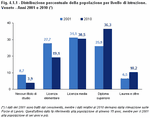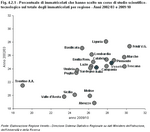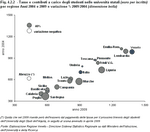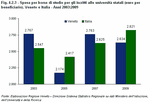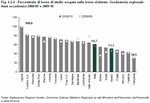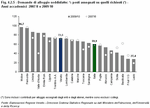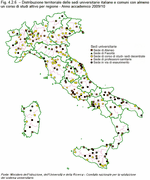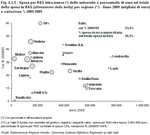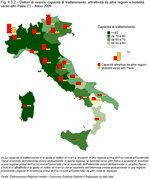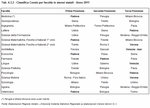
Chapter 4
Investing in education: a choice for the future
Youth is the starting point for transforming the recession into an opportunity for change. Their energy, talents and motivations are the tools which enable restoring and improving Italy's dynamicity and competitiveness. The future employment of young Italians depends primarily on a more efficient link between education, training and the labour market. In fact, compared to their peers of other Countries, young Italians start working at an older age and equipped with skills that are often useless due to the absence of previous contact with the world of labour. Investments in youth education is essential and should be increased to offer young people opportunities at pace with the social changes in place, without forgetting tradition, and create a qualified human capital which can contribute to the future development of Italy.
In light of this, Secondary School was reformed starting with the students beginning their studies in the new scholastic year 2010-2011. Quality and modernisation are the key words characterising the spirit of the school reform: a new, up-to-date school, in which priority is given to the quality of teaching over the quantity of study hours and the number of subjects studied, as recommended by the OECD. According to OECD, it is statistically proven that too many hours of study do not generate a beneficial impact on the learning outcomes of children.
This is a vast and organic operation for re-ordering the courses of study. An operation which 'strives to combine tradition with innovation, emphasising quality, with the objective of building the school of the future'; the different identities of upper secondary schools, technical institutes and vocational schools are recognised and enhanced, putting an end to the numerous experiments carried out at the beginning of the Nineties, which gave way to enormous fragmentation of subjects.
Among the strengths of the new Secondary School are the closer connections between university and higher education with the world of labour - through internships, apprenticeships, alternating of school and work activities - and with the local areas - due to the presence, in the technical and scientific committees, of representatives of local businesses. Finally, more space is given to science, mathematics and foreign languages in order to re-launch Italy in the international competition.
Participation in school is improving in the region: compared to data from 2005, in 2010 the proportion of 18-24 year old students who abandoned their studies prematurely dropped by almost four per cent, recording a value equal to 16%, thus reaching the Italian objective of 15-16% fixed for 2020 and getting close to the European objective of 10% outlined by the 'Europe 2020' strategy.
The regional offer of vocational training is also on the up: in the school year 2002-2003 the active courses were 739, and in 2011-2012 they became almost one thousand. The number of young people choosing vocational training has increased: from 11,300 to almost 19,400 and, in line with the nature of the territory, the courses with the most students are those relating to the mechanical sector, well-being services, and the food and catering industry.
On the contrary, foreign students, constantly increasing, in 2000-2010 were 0.9% of the scholastic population of Veneto, whereas in 2010-2011 they made up 8.1% of it. Foreign students prove to be more focused on vocational training, from which they can derive a well defined trade. In Veneto, in the school year 2009-2010, 45.7% of foreign students were enrolled to a vocational school and about 41.0% to a technical institute; such a situation signals the perpetuating of a social condition which sees foreigners mainly orientated towards purely manual or technical work. (Figure 4.1.2)
At the same time however, the priorities defined by the government in the Action Plan for Youth Employability - Italy 2020 - also include boosting technical and vocational education.
In fact, according to data from the Excelsior information system, both at the national level and in Veneto businesses still prefer hiring holders of technical and vocational diplomas, especially pertaining to administration and sales, followed by holders of diplomas related to mechanics and the hotel and tourism industry.
Technical and vocational education represents an opportunity for both young people and businesses, but not only for them, as the economic recovery cannot rely solely on the revival of the manufacturing sector and the 'made in Italy' brand, which are historically linked to technical and vocational education.
The surge in the number of youth choosing to attend a liceo upper secondary school can be beneficial since the large part of students who go on to study at universities usually come from liceo, and renewal and improvement of the Country's dynamics and competitiveness require high levels of education; however businesses often do not find the skilled labour force they need to compete on international markets, and many young people experience unemployment or underemployment situations because they have skills that the labour market does not need.
Therefore, the new educational reform affirms the need of developing constant and better connections between the world of labour, universities and the territory.
This is a vast and organic operation for re-ordering the courses of study. An operation which 'strives to combine tradition with innovation, emphasising quality, with the objective of building the school of the future'; the different identities of upper secondary schools, technical institutes and vocational schools are recognised and enhanced, putting an end to the numerous experiments carried out at the beginning of the Nineties, which gave way to enormous fragmentation of subjects.
Among the strengths of the new Secondary School are the closer connections between university and higher education with the world of labour - through internships, apprenticeships, alternating of school and work activities - and with the local areas - due to the presence, in the technical and scientific committees, of representatives of local businesses. Finally, more space is given to science, mathematics and foreign languages in order to re-launch Italy in the international competition.
The increase in the education level of Veneto over the last decade
Over the last decade, the population of Veneto have significantly increased their level of education: 46.5% of citizens at least hold a diploma, compared to the 32.4% share recorded in 2001. (Figure 4.1.1)Participation in school is improving in the region: compared to data from 2005, in 2010 the proportion of 18-24 year old students who abandoned their studies prematurely dropped by almost four per cent, recording a value equal to 16%, thus reaching the Italian objective of 15-16% fixed for 2020 and getting close to the European objective of 10% outlined by the 'Europe 2020' strategy.
The regional offer of vocational training is also on the up: in the school year 2002-2003 the active courses were 739, and in 2011-2012 they became almost one thousand. The number of young people choosing vocational training has increased: from 11,300 to almost 19,400 and, in line with the nature of the territory, the courses with the most students are those relating to the mechanical sector, well-being services, and the food and catering industry.
Changes in the choice of Secondary School
In the last few years the students of Veneto have shifted to academics to the detriment of technical and institutes and, in particular, of vocational schools: in 2011-2012, 43% of enrolments into State-run schools were directed towards 'liceo' upper secondary schools, against the 30% of 2000-2001.On the contrary, foreign students, constantly increasing, in 2000-2010 were 0.9% of the scholastic population of Veneto, whereas in 2010-2011 they made up 8.1% of it. Foreign students prove to be more focused on vocational training, from which they can derive a well defined trade. In Veneto, in the school year 2009-2010, 45.7% of foreign students were enrolled to a vocational school and about 41.0% to a technical institute; such a situation signals the perpetuating of a social condition which sees foreigners mainly orientated towards purely manual or technical work. (Figure 4.1.2)
At the same time however, the priorities defined by the government in the Action Plan for Youth Employability - Italy 2020 - also include boosting technical and vocational education.
In fact, according to data from the Excelsior information system, both at the national level and in Veneto businesses still prefer hiring holders of technical and vocational diplomas, especially pertaining to administration and sales, followed by holders of diplomas related to mechanics and the hotel and tourism industry.
Technical and vocational education represents an opportunity for both young people and businesses, but not only for them, as the economic recovery cannot rely solely on the revival of the manufacturing sector and the 'made in Italy' brand, which are historically linked to technical and vocational education.
The surge in the number of youth choosing to attend a liceo upper secondary school can be beneficial since the large part of students who go on to study at universities usually come from liceo, and renewal and improvement of the Country's dynamics and competitiveness require high levels of education; however businesses often do not find the skilled labour force they need to compete on international markets, and many young people experience unemployment or underemployment situations because they have skills that the labour market does not need.
Therefore, the new educational reform affirms the need of developing constant and better connections between the world of labour, universities and the territory.
If human capital is entrusted and acknowledged as a key competitive factor for development, universities are essential in shaping skills which will trace a new path of growth.
In this scenario, the reform of the Italian University System, entered into force in January 2011 (Note 1), aims at avoiding wastage of money and resources in universities and to develop governance based on merit and transparency.
According to the former Minister of Education Ms. Gelmini, 'the three year plan of 2010-2012 foresees the end of useless degree courses, of unnecessary remote campuses, of PhDs with a low number of participants, more rigour in the assessment of on-line universities, as well as the enhancement of degree courses in scientific and technological subjects'. Due to the consequent savings, 'greater resources will be given to deserving students experiencing economic difficulties, to support them in the completion of their university course.' (Note 2)
In brief, more quality, meritocracy, accountability, evaluation and incentives.
Italian university has been the subject of a deep change in the last decades: from the 288,000 students enrolled at the start of the Sixties, to the 1,048,000 enrolled in 1980-1981 and the 1,800,000 of 2009-2010. Participation in the universities of Veneto has also increased: compared to 2000-2001, in 2009-2010 the number of youth enrolled into the universities of the region grew by almost 16 per cent, garnering almost 19,000 new entrants, especially the University of Padua. Higher still is the power of the universities of Veneto to attract foreign students: their share went from 3.1% in 2004-2005 to 3.9% in 2008-2009; Albania is the most represented Country with 25% of the total of registered foreigners, followed at a great distance by Romania (8.3%) and Croatia (6.8%).
The rate of transition from upper secondary school to university increased compared to the previous year, but is still a long way from the levels recorded at the beginning of 2000: from the values of 72.3% and 69% of Italy and Veneto respectively in the academic year 2003-2004, in 2009-2010 it switched to 63.3% and 63.6%; a big deal of work is still to be done to achieve the European objective of raising the proportion of 30-34 years old people who reach graduation to at least 40% over the next ten years: in 2010, the percentage was equal to 18.6% in Veneto, compared 33.6% in the EU27.
In addition, among the most necessary measures, still remains the re-launch of the scientific and technological faculties, as science and technology are synonymous with new opportunities, innovation and competitiveness, but are still rarely chosen by Italian freshmen, although the phenomenon is growing: in Italy, in 2009-2010, 26.8% of enrolled students preferred scientific and technological studies compared to 24.2% in 2002-2003. In Veneto, the students choosing scientific studies at university are 28.4%, equal to over three and a half per cent more than seven years before; at the top is the Friuli-Venezia Giulia region with 30.3%, and the lower value is recorded in Trentino Alto Adige (19%). (Figure 4.2.1)
However, the fundamental change consists in the creation of a new and more innovative relationship between the educational system and the world of labour; such change requires a delicate reflection on the topic of mobility of university students.
The mobility of students is often hindered by cultural barriers and also serious logistical and financial difficulties. More investment should therefore be made to facilitate student mobility, going beyond the logic of campus multiplication and offering a real possibility of choice, expanding the availability of study grants and accommodation linked to merit, and making financial instruments available to students who want to invest in their own future.
In Italy, human resources represent the primary expense item of universities: in 2009, in State-run universities, about 65% of the resources were spent on personnel, of which 41.5% was spent on teachers.
Students also contribute to financing the university through the payment of fees and contributions, which are determined based on their personal economic conditions and the type of course of study they choose.
In 2009, families contributed over 1.6 million euros to financing Italian State-run universities and 536 million euros to private universities, i.e. 20% and 41% respectively more than in 2005.
The average contribution per enrolled student was higher in the Northern regions of Italy, where household income is higher. In 2009, with reference to State-run universities, the region where the students spent the most for university fees and contributions was Veneto (1,381 euro), with 230 euros more than two years before, followed by Lombardy and Emilia Romagna (1,324 and 1,285 euros respectively). Definitely lower is the spending in the Southern regions, where the household income is lower: in Puglia and in Calabria spending per student does not exceed 550 euros. The lowest expenditure was recorded in the Abruzzi (432 euros compared to 623 in 2007), where the students of the University of l'Aquila have been exempted from payment of fees for the next three years, following the earthquake which occurred in April. (Figure 4.2.2)
Furthermore, in the academic year 2009-2010, almost 29% of the students at State-run universities were totally or partially exempt from payment of university fees: in the North-West this percentage fell to 18%, in the North-East it stood at 22.6%, whereas in the South it reached 43.3%; but this share was affected by the exemption granted to the University of L'Aquila.
Compared with some other European Countries, among which there is still a non negligible discrepancy in the regulation of access to higher education and in the tools offered to help families, in Italy in 2008 spending aimed at supporting the costs of university students was over three per cent more than the average EU27 data and was higher than in France (7.4%), Spain (9.9%) and Germany (18.9%). The Country which spent the most on interventions in favour of students was the United Kingdom, with an incidence on university spending of over 31%.
After having recorded a continual increase, in 2009 spending on interventions to support the right to education for students enrolled in State-run universities fell slightly and reached the level of 535,405 thousand euros. Veneto absorbed 5.8% of the national total, with a spending on each regular student equal to 432 euros, lower than Italian data which was 498 euros. (Figure 4.2.3)
The main form of intervention granted to families for maintaining their child at university remains the study grant, which absorbs about 76% of the resources destined for subsidies. The national ranking for the amount of money assigned per recipient indicates Emilia Romagna as the region offering the most advantageous study grants (over 3,700 euros per study grant in 2009). Less lucrative is Veneto, which stands at around 2,600 euros per recipient.
Although, just over half of the applications for study grants for university degree courses are satisfied in Veneto, and fortunately the share of study grants disbursed compared to those requested is increasing: in only two years it passed from 41.8% (2007-2008) to 51.2% (2009-2010). The first position goes to Liguria, which satisfies the requests of students entirely, where as in Campania only satisfies 30% of requests. (Figure 4.2.4)
It is fundamental for a family and for the youth who has just graduated from secondary school and wants to go to university to have the opportunity to find low cost accommodation, especially if the location of the courses is far from home. The Regional Authorities for the Right to Education, and to a lesser extent the universities themselves, usually make accommodation and catering services available to students.
Over the last five years, in Italy the number of accommodation places managed by the regional authorities has continued to grow, and in the academic year 2010-2011 the accommodation offered by these authorities, together with that managed by the universities, reached 42,420 units, corresponding to 24 places available for every thousand enrolled students. The availability of accommodation changes considerably in the different regions, ranging from the 4 accommodation units every 1,000 students offered in Campania and the Abruzzi up to the Autonomous Province of Bozen, where this indicator reaches the maximum value of 242; Veneto is above the national average, as it offers 30 accommodation units each 1000 students.
In 2009-2010, in Italy, 60% of applications for accommodation and contributions for rent were met, with an increase of over 3 per cent compared to two years before. In this case the regional data varies in a remarkable way, from Molise and Piedmont, where 96.7% and 94.7% of requests were satisfied respectively, to Lazio, where only 27.4% of the demand was met. The performance in Veneto was good still, with a share of accommodation units assigned out of those requested equal to 72.5%, over one per cent more than in 2007-2008. (Figure 4.2.5)
According to the new reform in fact, one of the elements of criticality which undermines the effectiveness of the Italian university system is linked to the proliferation of universities. During the last two decades, the number of universities has significantly increased, and many of them are small and geographically dispersed: in such cases, the cost/benefit ratio and the possibility to offer of real educational opportunities to the students have not been evaluated with due attention and accuracy.
In Italy, the number of municipalities hosting at least one course of study grew from 127 in 2003-2004 to 251 in 2006-2007, and then diminished to 222 in 2010-2011, with 6 units less compared to the previous year and 20 less compared to 2008-2009. In particular, such decrease concerns municipalities were decentralised campuses where created for teaching first level courses.
Of these 222 municipalities hosting at least one course of study, 25.7% also host the main campus of a university, 15.8% are the seat of a faculty (but not of a university) and 58.6% are decentralised campuses where, however, in most cases only educational and training initiatives for the health professions (usually for a fixed number of students that is set at the national level) are carried out based on agreements with the National Health Service. (Figure 4.2.6)
In Veneto, the municipalities hosting at least one course of study are 18, and over half of them are decentralised university seats and three are being depleted. In particular, the campuses which are being depleted are mostly in the South of Italy, especially in the islands and in Calabria.
This process of revising the courses of study is already giving the first results, and the number of active courses (Note 5) present in the national territory is decreasing, especially due to the contraction of three year courses. In 2009-2010 in particular, 5,281 courses were active, i.e. 4% less than the previous year; 51% of such courses were laurea degree courses, 43% were laurea magistralis / laurea specialistica degree courses (i.e. second level degree courses), and 5.3% were single-level courses; to these, 28 degree courses belonging to the old system should be added, now being depleted, which represent 0.5% of the total. In Veneto 322 courses were counted, more than 10% less than in 2004-2005, whereas Lazio and Lombardy were confirmed as the regions with the widest educational offer.
In this scenario, the reform of the Italian University System, entered into force in January 2011 (Note 1), aims at avoiding wastage of money and resources in universities and to develop governance based on merit and transparency.
According to the former Minister of Education Ms. Gelmini, 'the three year plan of 2010-2012 foresees the end of useless degree courses, of unnecessary remote campuses, of PhDs with a low number of participants, more rigour in the assessment of on-line universities, as well as the enhancement of degree courses in scientific and technological subjects'. Due to the consequent savings, 'greater resources will be given to deserving students experiencing economic difficulties, to support them in the completion of their university course.' (Note 2)
In brief, more quality, meritocracy, accountability, evaluation and incentives.
Italian university has been the subject of a deep change in the last decades: from the 288,000 students enrolled at the start of the Sixties, to the 1,048,000 enrolled in 1980-1981 and the 1,800,000 of 2009-2010. Participation in the universities of Veneto has also increased: compared to 2000-2001, in 2009-2010 the number of youth enrolled into the universities of the region grew by almost 16 per cent, garnering almost 19,000 new entrants, especially the University of Padua. Higher still is the power of the universities of Veneto to attract foreign students: their share went from 3.1% in 2004-2005 to 3.9% in 2008-2009; Albania is the most represented Country with 25% of the total of registered foreigners, followed at a great distance by Romania (8.3%) and Croatia (6.8%).
The rate of transition from upper secondary school to university increased compared to the previous year, but is still a long way from the levels recorded at the beginning of 2000: from the values of 72.3% and 69% of Italy and Veneto respectively in the academic year 2003-2004, in 2009-2010 it switched to 63.3% and 63.6%; a big deal of work is still to be done to achieve the European objective of raising the proportion of 30-34 years old people who reach graduation to at least 40% over the next ten years: in 2010, the percentage was equal to 18.6% in Veneto, compared 33.6% in the EU27.
In addition, among the most necessary measures, still remains the re-launch of the scientific and technological faculties, as science and technology are synonymous with new opportunities, innovation and competitiveness, but are still rarely chosen by Italian freshmen, although the phenomenon is growing: in Italy, in 2009-2010, 26.8% of enrolled students preferred scientific and technological studies compared to 24.2% in 2002-2003. In Veneto, the students choosing scientific studies at university are 28.4%, equal to over three and a half per cent more than seven years before; at the top is the Friuli-Venezia Giulia region with 30.3%, and the lower value is recorded in Trentino Alto Adige (19%). (Figure 4.2.1)
However, the fundamental change consists in the creation of a new and more innovative relationship between the educational system and the world of labour; such change requires a delicate reflection on the topic of mobility of university students.
The mobility of students is often hindered by cultural barriers and also serious logistical and financial difficulties. More investment should therefore be made to facilitate student mobility, going beyond the logic of campus multiplication and offering a real possibility of choice, expanding the availability of study grants and accommodation linked to merit, and making financial instruments available to students who want to invest in their own future.
Spending on university education is increasing but still a long way from European targets
Spending on university education in 2008 reached a total of 19,542 million euros, 7.4% more than the previous year in real terms, and the share of GDP destined for the university system increased from 0.76% in 2005 to 0.84% in 2008. The incidence of spending on university education also grew out of overall public spending, which in the same time period went from 1.56% to 1.69%. Despite this, with the purchasing power being the same, in Italy the average expense per student was a little higher than 7,200 euros, i.e. almost 2,200 euros less compared to the average EU27 data and lower still than in France and Germany (11,574 and 12,649 respectively). In Italy, human resources represent the primary expense item of universities: in 2009, in State-run universities, about 65% of the resources were spent on personnel, of which 41.5% was spent on teachers.
Students also contribute to financing the university through the payment of fees and contributions, which are determined based on their personal economic conditions and the type of course of study they choose.
In 2009, families contributed over 1.6 million euros to financing Italian State-run universities and 536 million euros to private universities, i.e. 20% and 41% respectively more than in 2005.
The average contribution per enrolled student was higher in the Northern regions of Italy, where household income is higher. In 2009, with reference to State-run universities, the region where the students spent the most for university fees and contributions was Veneto (1,381 euro), with 230 euros more than two years before, followed by Lombardy and Emilia Romagna (1,324 and 1,285 euros respectively). Definitely lower is the spending in the Southern regions, where the household income is lower: in Puglia and in Calabria spending per student does not exceed 550 euros. The lowest expenditure was recorded in the Abruzzi (432 euros compared to 623 in 2007), where the students of the University of l'Aquila have been exempted from payment of fees for the next three years, following the earthquake which occurred in April. (Figure 4.2.2)
Furthermore, in the academic year 2009-2010, almost 29% of the students at State-run universities were totally or partially exempt from payment of university fees: in the North-West this percentage fell to 18%, in the North-East it stood at 22.6%, whereas in the South it reached 43.3%; but this share was affected by the exemption granted to the University of L'Aquila.
Increasing support and opportunities to students for higher education
For the improvement of the human capital, a fundamental role is providing direct financial support to the students and their families to cover enrolment and maintenance costs (such as study grants and loans), providing monetary contributions or other forms of assistance according to specific needs (such as housing or transport services) and concessions for families (family allowances and tax deductions). Certainly, offering quality services to students can help combating possible irregularity in their attending the courses; conversely, the absence of support services can accelerate the decision to abandon university. Compared with some other European Countries, among which there is still a non negligible discrepancy in the regulation of access to higher education and in the tools offered to help families, in Italy in 2008 spending aimed at supporting the costs of university students was over three per cent more than the average EU27 data and was higher than in France (7.4%), Spain (9.9%) and Germany (18.9%). The Country which spent the most on interventions in favour of students was the United Kingdom, with an incidence on university spending of over 31%.
After having recorded a continual increase, in 2009 spending on interventions to support the right to education for students enrolled in State-run universities fell slightly and reached the level of 535,405 thousand euros. Veneto absorbed 5.8% of the national total, with a spending on each regular student equal to 432 euros, lower than Italian data which was 498 euros. (Figure 4.2.3)
The main form of intervention granted to families for maintaining their child at university remains the study grant, which absorbs about 76% of the resources destined for subsidies. The national ranking for the amount of money assigned per recipient indicates Emilia Romagna as the region offering the most advantageous study grants (over 3,700 euros per study grant in 2009). Less lucrative is Veneto, which stands at around 2,600 euros per recipient.
Although, just over half of the applications for study grants for university degree courses are satisfied in Veneto, and fortunately the share of study grants disbursed compared to those requested is increasing: in only two years it passed from 41.8% (2007-2008) to 51.2% (2009-2010). The first position goes to Liguria, which satisfies the requests of students entirely, where as in Campania only satisfies 30% of requests. (Figure 4.2.4)
It is fundamental for a family and for the youth who has just graduated from secondary school and wants to go to university to have the opportunity to find low cost accommodation, especially if the location of the courses is far from home. The Regional Authorities for the Right to Education, and to a lesser extent the universities themselves, usually make accommodation and catering services available to students.
Over the last five years, in Italy the number of accommodation places managed by the regional authorities has continued to grow, and in the academic year 2010-2011 the accommodation offered by these authorities, together with that managed by the universities, reached 42,420 units, corresponding to 24 places available for every thousand enrolled students. The availability of accommodation changes considerably in the different regions, ranging from the 4 accommodation units every 1,000 students offered in Campania and the Abruzzi up to the Autonomous Province of Bozen, where this indicator reaches the maximum value of 242; Veneto is above the national average, as it offers 30 accommodation units each 1000 students.
In 2009-2010, in Italy, 60% of applications for accommodation and contributions for rent were met, with an increase of over 3 per cent compared to two years before. In this case the regional data varies in a remarkable way, from Molise and Piedmont, where 96.7% and 94.7% of requests were satisfied respectively, to Lazio, where only 27.4% of the demand was met. The performance in Veneto was good still, with a share of accommodation units assigned out of those requested equal to 72.5%, over one per cent more than in 2007-2008. (Figure 4.2.5)
Creating a more efficient system with less decentralised campuses
The idea that the true right to education consists in giving 'capable and deserving' students the opportunity to go to the universities which are more adapted to their ability and inclination, even if far from home, involves investing significantly in study grants and off-site accommodation facilities for students. Consequently, the number of decentralised university campuses should be significantly reduced and the resources thus saved should be reinvested to support the mobility of students and their right to education. According to the new reform in fact, one of the elements of criticality which undermines the effectiveness of the Italian university system is linked to the proliferation of universities. During the last two decades, the number of universities has significantly increased, and many of them are small and geographically dispersed: in such cases, the cost/benefit ratio and the possibility to offer of real educational opportunities to the students have not been evaluated with due attention and accuracy.
In Italy, the number of municipalities hosting at least one course of study grew from 127 in 2003-2004 to 251 in 2006-2007, and then diminished to 222 in 2010-2011, with 6 units less compared to the previous year and 20 less compared to 2008-2009. In particular, such decrease concerns municipalities were decentralised campuses where created for teaching first level courses.
Of these 222 municipalities hosting at least one course of study, 25.7% also host the main campus of a university, 15.8% are the seat of a faculty (but not of a university) and 58.6% are decentralised campuses where, however, in most cases only educational and training initiatives for the health professions (usually for a fixed number of students that is set at the national level) are carried out based on agreements with the National Health Service. (Figure 4.2.6)
In Veneto, the municipalities hosting at least one course of study are 18, and over half of them are decentralised university seats and three are being depleted. In particular, the campuses which are being depleted are mostly in the South of Italy, especially in the islands and in Calabria.
... and rationalising degree courses
As shown by the reform, however, a rationalisation of the university degree courses is undoubtedly essential to increase efficiency and quality. The logic is to shift from the proliferation of courses which followed the Ministerial Decree 509/99 (Note 4) and the 3+2 model, to a real assessment of the needs of the students and the world of labour, in order to design an educational offer aimed at the achievement of learning outcomes by the students and at meeting the occupational needs of the territory. This process of revising the courses of study is already giving the first results, and the number of active courses (Note 5) present in the national territory is decreasing, especially due to the contraction of three year courses. In 2009-2010 in particular, 5,281 courses were active, i.e. 4% less than the previous year; 51% of such courses were laurea degree courses, 43% were laurea magistralis / laurea specialistica degree courses (i.e. second level degree courses), and 5.3% were single-level courses; to these, 28 degree courses belonging to the old system should be added, now being depleted, which represent 0.5% of the total. In Veneto 322 courses were counted, more than 10% less than in 2004-2005, whereas Lazio and Lombardy were confirmed as the regions with the widest educational offer.
University research ... a crucial element for a positive evolution
If investing in education is essential for boosting the economy of the Country, and research cannot be neglected. Research, innovation, competitiveness and culture are the motor of development, as is also shown by the great results achieved by those Countries which invest the most in research.A very important contribution comes from the world of university: in the modern scenario of research, the position of universities is crucial since their research activities have a significant impact on territorial development. Investing in university research and improving its quality, making the organisation of research more effective and efficient, developing cooperation relationships with local businesses and technical institutions, and accessing new financial sources, is surely a strategic for the development and competitiveness of a Country at the international level.
In 2009, the spending for Research and Development (R&D) of Italian universities was about 5,812 million euros, i.e. an amount 4.7% less than the previous year but higher by over 23% of the spending of 2005. Veneto is in the fourth position in the ranking of Italian regions: in 2009, its spending on R&D amounted to over 394,000 thousand, equal to 6.8% of the national total, with an increase of about 2% compared to 2008 and of 35.5% compared to four years before. (Figure 4.3.1)
Over a quarter of spending for university research is concentrated in two regions: Lombardy and Lazio, but in Calabria and Sardinia the resources used by the universities are higher compared to the total regional spending on R&D (in Calabria 79.7%, in Sardinia 73.1%), signalling that in these two regions the investments from the business world are marginal and therefore far away from the Lisbon objective of increasing the investment of business to such an extent that by 2010, two thirds of spending on R&D is invested by businesses. Conversely, the lowest values of this share, recorded in the North, demonstrate that research activities are mainly carried out outside universities (in Veneto it is equal to 25.8%).
Within the range of the Countries with which a significant comparison can be made, after Portugal Italy is the Country that recorded the biggest contribution to university research activities out of the national total of spending on R&D. In 2008, in fact, such ratio was around 32% higher than the EU27 average of 23.1% and was above the data recorded for Spain, France and Germany, equal to 26.7%, 19.7% and 16.2%, respectively.
Attracting and retaining the research doctors to increase innovation
A strong contribution to the competitiveness and the future development of the Country is given by research doctors. The research doctorate constitutes the highest degree of specialisation offered by the university, both for those who intend to dedicate themselves to research and for those who want to enter the manufacturing world equipped with significant skills and capacities in planning and research. In Countries excelling in competitiveness at a international level, the businesses use and generously finance research doctorates as extraordinary opportunities to innovate and grow, to recruit the most talented persons and invest in the excellence required by the new labour markets. In Italy, however, the research doctor mostly partakes in an academic career. Needless to say, as is also emphasized in the 'Action Plan for Youth Employability- Italy 2020', using research doctors to support research in the private sector and creating professional figures that are strategic for businesses is definitely essential. Even before that, it is fundamental to offer research doctors worthy opportunities, thus avoiding the risk of 'brain drain'.
The capacity of each region to retain and attract research doctors can be assessed based on the survey made by Istat in 2009 on professional insertion of research doctors who were awarded their PhD qualification five and three years before (i.e. in 2004 and 2006). The comparison between the region of residence of research doctors prior to their enrolment into university and the region in which they were habitually living at the time of the interview allows to study their migration both inside the Country and abroad.
The retention ability was measured by the share of research doctors who were resident in a region before their enrolling in university and who in 2009 were still living in the same region; Lazio resulted to have the greater retention ability, with a share of 85%; Piedmont also exceeds 80% as well as Lombardy, Emilia-Romagna, Tuscany and Sardinia, whereas more than 50% of research doctors from Basilicata and the Aosta Valley (Note 6) emigrated to another region. Veneto was in the middle with a percentage of 74.5%. (Figure 4.3.2)
The Northern regions also have the largest proportion of research doctors migrating abroad: in particular, Veneto is the third among the regions with the highest value (9.5%), whereas Calabria does not even exceed 3%. The performance of Veneto is good however with regards to the ability to attract research doctors, which is measured by the share of PhDs who, before enrolling in a university, lived in other regions: over 27% moved to Veneto to find work; at the top is Trentino-Alto Adige which, despite a small retention capacity, recorded an index of 51%. Also attractive are Emilia-Romagna (31.3%), Lombardy (28.1%), Tuscany (26.9%), Lazio (24.9%) and Piedmont (24.3%).
The Italian universities in an international context
But how are Italian universities compared to foreign universities? Comparison between universities, both at and international and a national level, is made based on specific rankings each of which uses a different system of parameters and therefore offers slightly different results. We therefore use the available data to draw from these rankings an overall assessment of the various university systems, rather than the ranking position of each individual university.
We first take into consideration the international position of the Italian university system according to the QS World University Ranking, which defines the 500 best universities in the world. In this ranking, the universities are assessed based on six indicators, relative to peer assessment, assessment of employers, presence of foreign students and teachers, and publications - weighted based on number of quotations - and the student to teacher ratio (Note 7).
In 2010 as many as 15 among the top 500 universities in the world were Italian, although the first Italian university listed in the ranking, that of Bologna, was in the 176th position, followed by La Sapienza of Rome (190th) and the University of Padua (261st).
But what is really interesting and important to point out, as declared in the Eleventh Report on the State of the University System (Note 8), is that the aforesaid 15 Italian universities represent, overall, almost 42% of the national university system in terms of number of students and 46.5% in terms of teachers.
There is then the Shanghai index, which assesses the quality of universities, taking into account different indicators of performance and excellence such as the number of students or teachers who have won the Nobel Prize or the Fields Medal, the papers and articles published and related quotations in the best journals, etc.; using this methodology, in 2011 the university of Pisa and La Sapienza of Rome was placed within the group from the 101st to the 150th , whereas the University of Milan and that of Padua were in the group from the 151st to the 200th university. (Table 4.3.1)
Finally, it is worth mentioning the Taiwan ranking, which differently from the others is based exclusively on indicators of productivity and scientific impact, and therefore concentrates only on the scientific performance of the universities and perhaps best represents the Italian universities: in fact, as many as 29 Italian universities rank among the top 500 of the world, compared to the 22 of the Shanghai ranking. According to this index, the University of Padua ranks higher, as the second best among Italian universities and 104th in the world.
The good performance of Padua at the national level
The national ranking of Italian universities is established by Censis (Italian Centre for social investment studies). Each university is given a score between 66 and 110 based on five parameters: services offered, spending on study grants and other interventions in support of the students, facilities, presence and services on the Web and internationalisation. For greater accuracy, various rankings are drawn up on the basis of size and type of State-run universities, which are for this purpose sorted in five classes: mega universities, with over 40,000 students enrolled; large universities, with 20-40 thousand students; medium universities, with 10-20 thousand students; small universities, with less than 10 thousand students; and the polytechnic universities.
With regards to the universities of Veneto, in 2011 Padua ranked second best in Italy among the mega State-run universities and the Iuav of Venice ranked third among the polytechnic universities.
The individual faculties and departments are also assessed and ranked based on the teaching level, productivity (number of studies that finish their studies within the prescribed time for their specific degree course), level of research and international relationships; the result is that the best ones are not always found in the best universities.
Such ranking indicates that in Italy Padua is the best State-run university for studying Medicine, Veterinary Science, Economics as well as Mathematic, Physic and Natural Sciences (1st level, 3 years' course); it is the second for Pharmacy and third for Literature and Psychology. The performance of Verona and Venice is also good: Verona ranked third for Motor Sciences and Mathematic, Physic and Natural Sciences (2nd level); Venice ranks third for the faculty of Languages and Iuav is third for Architecture. (Table 4.3.2)







